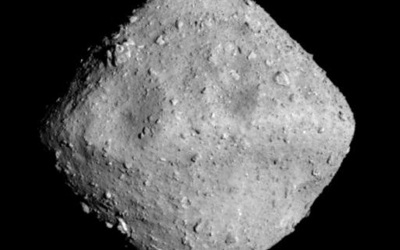Material from asteroid Ryugu starts to give up secrets of early Solar System

Just over a year ago, material from the Japanese Hayabusa 2 mission to Asteroid (162173) Ryugu arrived back on Earth . And this week, the first two papers reporting analysis of the material have been published in Nature Astronomy.
Excitingly, they suggest we may be on the brink of discovering whether water and organic material, which enabled life on Earth, really came from asteroids like it.
The Hayabusa 2 mission orbited Ryugu for 18 months between June 2018 and November 2019, returning fascinating images and data from the spinning-top-shaped body. One of the most important aims was to collect material from its surface, which it did in two tricky manoeuvres. The separate touch-downs were designed to collect material from different layers of the asteroid.
The first fired a small bullet into the asteroid near its equator, collecting some of the surface dust that was distributed. A second, larger impact produced a crater, with material collected from it in a second touchdown. This was important, as these grains had not been exposed to the outside space environment.
In total, Hayabusa 2 collected almost 5.5g – about a teaspoonful – of dust. This doesn’t sound much, until you consider that there are several thousand individual grains, each of which could be analysed by special instruments on Earth.
Ryugu is a C-type asteroid – rocky and dark bodies that are rich in carbon and water. Crucially, they have survived since the birth of the Solar System without losing their primitive composition. This, however, does not mean that they are unchanged. “Carbonaceous chondrites”, meteorites that have been found on Earth and are thought to have come from C-type asteroids, have many features that indicate that they have been altered by fluids.
These bodies, thought to have formed at the outer reaches of the asteroid belt, contained ice mixed in with the rock. Some of the ice, however, has melted – leading to the production of clay minerals and carbonates (salts). One of the aims of the Hayabusa 2 mission was to investigate the link between C-type asteroids and carbonaceous chondrites. Were C-type asteroids really the parent bodies from which carbonaceous chondrites originated?
This is important because carbonaceous chondrites are probably the sort of objects that brought water and organic compounds to Earth, enabling life to emerge here.
New insights
As they were irreplaceable samples, the analyses started with non-invasive and non-destructive observations and are being followed by complex measurements that require specimens to be manipulated and prepared, an ongoing process.
So what are the preliminary results? The bulk density of Ryugu was measured by Hayabusa 2 to be around 1,190 kilograms per cubic metre. This was as expected, since the asteroid is assumed to be a rubble pile of material that has come together following the collision of a larger body. It, like most asteroids, has a high porosity – lots of void spaces between the rocky components.
But it was a surprise that the density of the collected material was similarly low in density, at around 1,300 kilograms per cubic metre. This is surprising because the collection process should have collapsed the voids and leave a denser heap of particles. These particles would also have been further shaken together during transit and atmospheric entry. The density is also much lower than that of the meteorites presumed to be similar to Ryugu.
The authors speculate on two complementary reasons for this. Meteorites that ended up on Earth were once removed by collision from their parent asteroid. Unlike the Ryugu material, which was protected by its capsule, their final dramatic plunge through Earth’s atmosphere had a direct effect on them – causing break-up and fragmentation. So the meteorites that arrive on Earth have had at least one additional event that could cause their porosity to decrease. Ryugu may also contain more low-density material, such as organic molecules, than such meteorites.
This is extremely important because it implies that the material from Ryugu has preserved a component of carbonaceous material that we have not been able to study before. This should allow us to learn more about the primordial building blocks of life.
The composition of many of the Ryugu grains has also been evaluated by spectroscopy – a technique that shines light on a sample and measures the wavelength of the light reflected back. This is not the most usual of techniques for preliminary compositional analysis – but it has been employed because it is non-destructive, requires no sample preparation, and enables direct comparison of the grains with measurements taken of the surface of Ryugu by Hayabusa 2.
As would be anticipated, the spectra of the grains (from both touchdowns) and the asteroid surface are very similar and all contain the same fingerprint for water (as OH, hydroxide). The more detailed laboratory analysis, at higher wavelengths than measured at the asteroid, found additional features, one of which is identified as from a nitrogen-bearing component, which, the authors suggest, might be from ammonium-bearing clay minerals or nitrogen-rich organic material. That said, we don’t yet know how abundant organic compounds might be in the samples – that must wait for a different analytical technique.
The authors also found a huge carbonate grain about half a millimetre long that could be iron-rich – very characteristic of this type of meteorite.
This is, however, preliminary analysis. The papers have achieved two things: the first is that they have shown us that the material from Ryugu is primitive and sufficiently different from known meteorites to make us think again about how representative meteorites are of asteroids. This might come to change some aspects of our view of early Solar System history.
And the second thing? They have left us – okay, me – desperate to learn more about these precious materials. I await eagerly the next set of papers and – even more keenly – an opportunity in the future to analyse a sample myself.
Thank you JAXA and thank you Hayabusa 2 team. You have brought at least one planetary scientist some real festive joy at the end of a difficult year. And a great deal to look forward to in 2022.![]()
Monica Grady, Professor of Planetary and Space Sciences, The Open University
This article is republished from The Conversation under a Creative Commons license. Read the original article.
Quarterly Review of Research
Read our Quarterly Review of Research to learn about our latest quality academic output.

Contact our news team
For all out of hours enquiries, please telephone +44 (0)7901 515891
Contact details